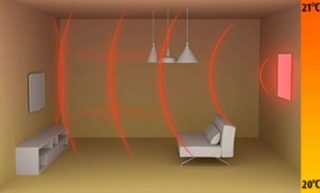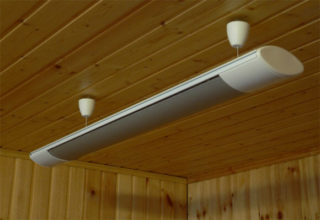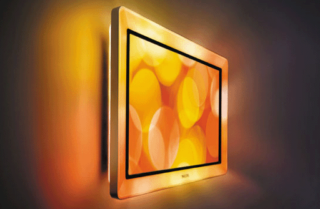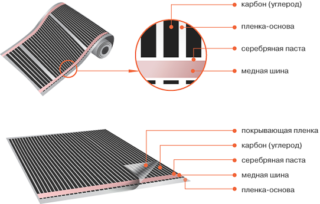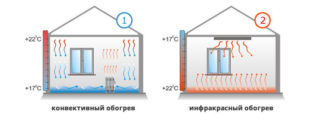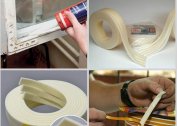Infrared heating for home and summer cottages is the most economical, since appliances of this type are characterized by efficient electricity consumption. But in order for it to bring maximum benefit, you need to know the basic principles of operation and features of different types of heating devices.
Operating principle
In the process, infrared heat is transmitted not by the traditional convection method, but by radiation. The heat rays that the device emits do not heat the air currents in the room, but material objects: walls, furniture, the skin of people and animals. This leads to lower costs for heating the air, the heat after connecting the device is felt almost instantly.
These qualities allow you to feel comfortable in a room where the temperature has dropped by about three degrees. You do not have to spend electricity on additional heating.
Types of infrared heating
There are three types of heaters that are used for infrared heating of a private house: ceiling devices, infrared panel heaters for wall-mounted heating and film options. There are also freestanding IR heaters - they are used for additional heating of rooms or an outdoor recreation area.
Ceiling fixtures
This option of infrared heating is the most popular because it is practical, equipped with inexpensive emitters. It consists of a heat heater and a reflective element made of aluminum, which provides directional radiation of infrared waves.
Such devices are mounted directly on the ceiling or on the wall under it.
The heater is directed to the floor and slightly to the side. As a result, the flooring and the opposite walls below are the most heated.
If the climate is mild, infrared devices can become the main ones in the heating system. Otherwise, it is a good additional source of heat, capable of forming separate “hot” zones.
Wall panels
Such infrared batteries are used as an alternative to a standard radiator. Modern panels look stylish and do not spoil the interior, like bulky radiator water circuit devices.
Panel heaters are called ceramic: they include ceramic tiles that emit infrared rays. Wall panels are more effective than those that are mounted on the ceiling, because the design provides not only infrared heating, but also air convection.
IR film
Infrared film heating (PLEN) is one of the inexpensive and effective options. The device looks like a film, inside of which a thin heating element is zigzagged. The film coating is usually laid under a laminate, linoleum, carpet, tile.
The main plus of the PLEN is that it consumes a minimum of energy.
However, such a heating system as the only one is suitable only for regions with a warm climate. In Russian conditions, the film will benefit exclusively as an additional heating element.
Film heaters are used not only as a substrate for flooring. PLEN is installed under wall finishing materials, most often under gypsum boards. Infrared plasterboard heating can actually be equipped even on the ceiling.
Specifications
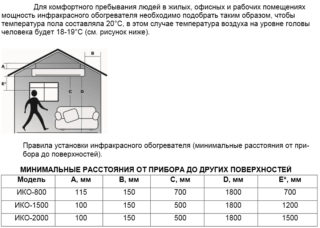 Before choosing a heating system, you need to consider the main technical indicators.
Before choosing a heating system, you need to consider the main technical indicators.
Emitter power
For household devices, this indicator ranges from 300 to 2500 watts.Given the effectiveness of such placement, a device of not more than 800 watts is usually sufficient to heat a room. If the ceiling heater has high power, it is rational to mount it in rooms with high ceilings.
Industrial equipment has high rates - from 2500 W and above. Typically, emitters of such devices operate in a wider spectral range, which is safe only in industrial premises.
Wavelength
IR equipment is also classified by wavelength. Devices are:
- long-wave (from 50 to 1000 microns);
- medium-wave (from 3.2 to 50 microns);
- shortwave (from 0.74 to 3.2 microns).
The indicator is directly related to the radiation temperature. The shorter the waves, the higher the temperature the device operates. Therefore, long-wave models are considered completely safe in everyday life. They have no contraindications and positively affect the work of the human body, for example, increase immunity. Other types of devices are used for street heating or heating production.
Power supply
Household heaters are most often powered from an AC source of 220 V, while powerful industrial models require a three-phase connection of 380 V.
Moisture protection
Infrared equipment with protection class IP24 and higher is not afraid of high humidity. It can be installed in the bath, sauna or bath.
Advantages and disadvantages
If we compare the heating by infrared radiation with other methods of heating the premises, the advantages are immediately noticeable:
- wide scope;
- quick heating of the room;
- noiselessness and lack of vibration;
- compactness;
- low inertia;
- temperature increase in individual zones, if necessary;
- integration into the smart home scheme;
- easy installation and disassembly;
- reliability and durability.
Infrared heaters are economical. But in order to achieve a rational energy consumption, it is necessary to observe a number of requirements, among which it is possible to note the insulation of buildings and the installation of reflective screens that reduce heat loss. With the right approach, you can equip a heating system with costs of only about 2000 rubles per month.
With regard to the effect on human health, ceiling fixtures can be harmful if they are suspended low above the desktop. The device will constantly heat the scalp. But IR devices, unlike spiral ones, do not dry the air and do not burn oxygen out of it.
I crackle some models when heating and cooling, since metals that have different degrees of expansion when heating and cooling, for example, steel and aluminum, are used for the manufacture of the device. But this does not affect the quality of work.
When choosing an IR device, pay attention that the package includes a temperature controller - mechanical or electronic. The device allows you to maintain a comfortable temperature in a given mode.
